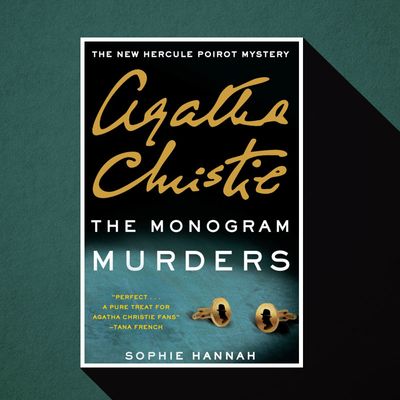
How does a writer bring one of the greatest detectives that crime fiction has ever produced back to life? Hercule Poirot, Agatha Christie’s elegant Belgian detective, he of the exquisitely groomed mustache and constantly whirring little gray cells, died of a heart attack in 1975. The crime novelist Sophie Hannah had never imagined that any writer would summon him back to the page. “I would no sooner have considered it than I would have considered applying to be the queen of England,” she says. And yet, when her agent informed her that the Christie family was seeking a writer to revive the great man, she realized she already had a plot in mind. “I think the only reason I could do it was because I’d read all of her Poirot novels so many times they literally were programmed into my brain,” she explained in a recent phone call.
Hannah’s resurrected Poirot first delivered one of his famous denouements in 2014, in the ingeniously plotted The Monogram Murders. While the critics debated about how well she re-created the great investigator (the Independent praised it as “immensely satisfying”; the Guardian slighted it as “diluted essence of Poirot”) the author continued to lead the sleuth through a series of mysterious and murderous adventures. Her fourth Poirot novel will be out next summer. Here, Hannah walks us through how she channeled the goddess of crime fiction.
I’ve been an Agatha fan since I was 12 years old, but writing a new Agatha Christie novel is just not something that would ever have occurred to me. My agent was the one who suggested it to Harper Collins. He was at their offices for a meeting about one of his other authors, and he happened to be sitting in a room that was full of Agatha Christie novels. Off the top of his head, he proposed the idea. The editor said, “Oh no, the family would never want something like that to happen.” But as it turned out, at that very moment the Christie family were deciding they did, in fact, want more books to be written. It was an incredible coincidence.
I think the Christies wanted a way to remind people that Agatha Christie is still a very relevant and popular writer. Sherlock Holmes and James Bond were being revived and given new leases on life. Why not Agatha? So a meeting was arranged. They asked whether I’d prefer to write Poirot or Marple. And although I love them both equally as a reader, the idea that was forming in my brain for a possible Christie continuation novel felt more suited to Poirot. As soon as I’d heard about the possibility, I realized this idea I’d had two or three years earlier and hadn’t managed to make work would actually be perfect for a Poirot novel. Before Poirot, I’d always written contemporary crime novels, and this idea was not a contemporary idea. The mind-set required for the plot to work is more old-fashioned.
I thought the plot would be better suited to Poirot because the solution to the mystery was very clever. Poirot likes showing off when he delivers the solution to the mystery, and I could already picture him showing off his solution to a roomful of people. There are some elements Christie’s Poirot plots always involve. There’s always a super clever ending, a very staged denouement scene where everyone is gathered together and the solution is revealed, sometimes at great length. Then there are the clues, red herrings, the completely unguessable and unpredictable plot. The real genius of Agatha is that she plays absolutely fair with you. All the clues are there, but you just never guess where her plots are going.
The Christie family and I discussed setting the new books in the present day. I knew instantly I would not want to do that. The whole thing about Poirot is he’s not contemporary, and anyone who might want to read a new Poirot novel would not want Poirot to be changed. If I had invented a version of him that existed now, would he have a Twitter account? Would he be on Snapchat? I don’t like it when something traditional and brilliant is messed with. This happened to me once — I went to see Macbeth, it was some innovative new director who was doing the production. It wasn’t set in Scotland, it was set in, I don’t know, a call center in South London. No. That is not Macbeth! The Christie family was delighted when they discovered how traditional I was. You know, I love new and exciting, but I saw my job as bringing a new and exciting mystery to the traditional Poirot, not to start messing with any aspects of Poirot as a character. I also don’t think Agatha feels dated at all. That’s partly because what drives her plots are things that are equally true of humans today. People still kill because of extreme jealousy, or because they’re terrified their secret will be found out. She goes for these archetypal, eternal, human dilemmas. She’s classic but not dated, which is, you know, obviously the ideal.
We also debated exactly when to set my Poirot. He dies at the end of Agatha’s last book about him, Curtains. I certainly didn’t want to bring him back to life because that never works. Remember when Bobby Ewing came back to life in Dallas? Nobody was impressed. There was some talk about my Poirot novel being a prequel to The Mysterious Affair at Styles, which was Agatha’s first, but we decided that wouldn’t work because Agatha’s first Poirot novel should always remain the first Poirot novel. Then my editor at HarperCollins pointed out there were four years between 1928 and 1932 when Agatha didn’t write any Poirot novels. He was unaccounted for. In all of our opinions, that was the classic Poirot era, so my first, The Monogram Murders, is set in 1929, and the next two, which are called Closed Casket and the Mystery of Three Quarters, are both set in 1930.
I didn’t do too much historical research. I needed to know if certain things existed in 1929, like whether hotels had elevators, or if most private homes had telephone lines. I did stay in Agatha’s holiday home, Greenway, which is an absolutely stunning house in the Devon countryside. I stay there quite regularly now, but initially I stayed there while I was writing the plan of The Monogram Murders. I always knew I wanted to stay there, but until I did, I thought, come on, you know, it is just a house. There’s no way I’m going to stay there and suddenly be filled with Poirot inspiration. And yet, that was exactly what happened.
Once I started writing Agatha novels myself, I realized how much I’d absorbed her influence over the years. I never had to think, I hope I’m doing enough Agatha-ish things. I saw, in fact, that all the contemporary crime novels I’d written were pretty Agatha-ish already in their priorities and structure. I don’t think I could have written any other author’s detective in the same way. I didn’t find it intimidating to write Poirot precisely because nobody can fill Agatha’s shoes. I knew I could write a book and feel proud of it, and okay, maybe it wasn’t going to be as good as Agatha Christie, but I think that’s an unrealistic thing to aim for. What I wanted to do was write books that were good enough to really appeal to people who love Agatha and loved Poirot.
In some ways, Poirot is a bit like a superhero. His personal life, if he has one, doesn’t get in the way. At the same time he is a flawed, slightly weird character. And so he seems very real. Once you’ve encountered Poirot, you just don’t forget to him. He’s visually memorable — the way he talks, the way he thinks. All his little foibles, his insistence on order and method. I think he’s just the best character crime fiction has ever produced.
More From This Series
- How I Learned to Write Mysteries the Mystic River Way
- The Crimes Never End: A Guide to Mystery’s Biggest, Longest-Lasting Franchises
- How ‘Who Shot Mr. Burns?’ Unlocked The Simpsons’ Potential


